During the last month, I had several projects which use Aruba InstantAP Mesh. So I would like to share my experience with Aruba InstantAP Mesh.
IAP Mesh is a technology to either connect remote IAP’s to the cluster, if no ethernet connection is available, or to connect different networks with each other when no wired connection is available.
InstantAP Mesh – Basics
IAP mesh is very simple and easy to configure. The setup consists of two components, the Mesh Portal, which has a wired connection and provides the wired connection for all Mesh Points, which are the AP’s with no wired connection. In the IAP world, you cannot specify a dedicated Mesh Portal. A Mesh Point will always connect to the best Mesh Portal available, measured by signal strength.
To form a Mesh, all IAP’s has to be part of the same IAP cluster. This is important, as each cluster has its own VC Key. The IAP use this VC Key to identify the correct Mesh connection.
The first step is to create a PSK based SSID. I assume you know how to do this. Here is mine, just for testing:
wlan access-rule Aruba
index 2
rule any any match any any any permit
wlan ssid-profile Aruba
enable
index 0
type employee
essid Aruba
wpa-passphrase 601d3a32a2a881f36c538b377bb4d37a225e65cdc35cf2ea
opmode wpa2-psk-aes
max-authentication-failures 0
rf-band all
captive-portal disable
dtim-period 1
broadcast-filter arp
dmo-channel-utilization-threshold 90
local-probe-req-thresh 0
max-clients-threshold 64Next step is to disable the extended SSID mode. Go to “System–>General” and enable the advanced mode (click the link at the bottom of the window “Show Advanced Options”) and disable the “Extended SSID” option:
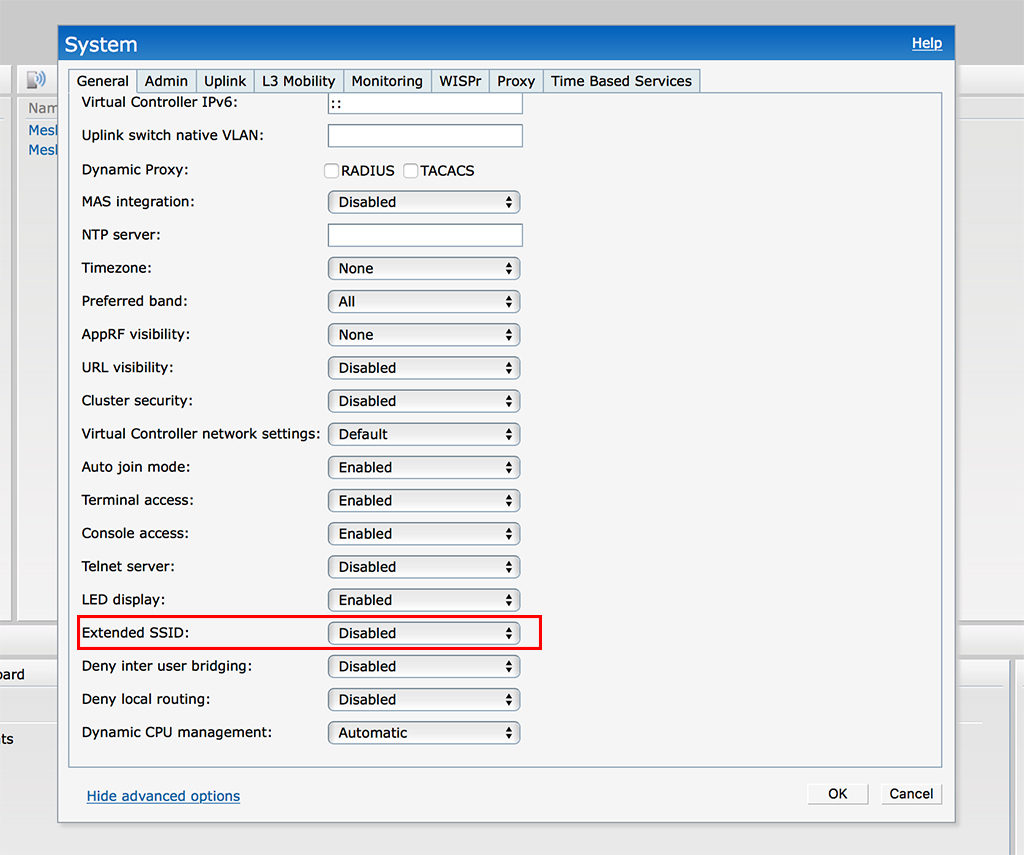
You can also use the CLI:
# no extended-ssid
# exit
# commit apply
committing configuration...
configuration committed.
# wr memory
Save configuration.You need to reboot all AP’s in the Cluster to disable the Extended SSID mode. Afterward, you can check the state of the extended SSID mode:
# show swarm state
AP Swarm State :swarm_config_sync_complete
mesh auto eth0 bridging :no
Config in flash :yes
factory SSID in flash :no
extended-ssid configured :no
extended-ssid active :no
Factory default status :no
Source of system time :NTP server
Config load cnt :1
VC Channel index :1
IDS Client Gateway Detect :yes
Config Init success cnt for heartbeat :0
Config Init success cnt for register :0
Config Init skipping cnt for heartbeat :0
Config Init skipping cnt for register :0
Config Init last success reason :N/A
Config Init last success time :N/AThe AP’s are now ready to build a mesh. If one of the AP’s loose wired connectivity, the AP switches to mesh. This happens automatically but can take up to 15mins. The AP will reboot and during boot, you will see the following messages:
Ethernet uplink not active yet
Ethernet uplink not active yet
No uplink active. Becoming Mesh PointThe first 2 lines will repeat many times. After the last line, the AP will boot normally.
You can now check in the Web and CLI if the Mesh is up and running:

As you can see in the screenshot above, one AP is the Portal and one is the Point. You can get even more details from the CLI:
show ap mesh neighbours
Neighbor list
-------------
MAC Portal Channel Age Hops Cost Relation Flags RSSI Rate Tx/Rx A-Req A-Resp A-Fail HT-Details Cluster ID
--- ------ ------- --- ---- ---- ----------------- ----- ---- ---------- ----- ------ ------ ---------- ----------
38:17:c3:09:92:51 80:8d:b7:10:77:b0 116E 0 1 1.00 C 41m:15s VLK 35 650/390 4 4 0 VHT-80MHzsgi-2ss bfb3420907204759d77aa4aa01e848a
Total count: 1, Children: 1
Relation: P = Parent; C = Child; N = Neighbor; B = Blacklisted-neighbor
Flags: R = Recovery-mode; S = Sub-threshold link; D = Reselection backoff; F = Auth-failure; H = High Throughput; V = Very High Throughput, L = Legacy allowed
K = Connected; U = Upgrading; G = Descendant-upgrading; Z = Config pending; Y = Assoc-resp/Auth pending
a = SAE Accepted; b = SAE Blacklisted-neighbour; e = SAE Enabled; u = portal-unreachable; o = opensystemor this one:
show ap mesh link
Neighbor list
-------------
MAC Portal Channel Age Hops Cost Relation Flags RSSI Rate Tx/Rx A-Req A-Resp A-Fail HT-Details Cluster ID
--- ------ ------- --- ---- ---- ----------------- ----- ---- ---------- ----- ------ ------ ---------- ----------
38:17:c3:09:92:51 80:8d:b7:10:77:b0 116E 0 1 1.00 C 41m:19s VLK 35 702/390 4 4 0 VHT-80MHzsgi-2ss bfb3420907204759d77aa4aa01e848a
Total count: 1, Children: 1
Relation: P = Parent; C = Child; N = Neighbor; B = Blacklisted-neighbor
Flags: R = Recovery-mode; S = Sub-threshold link; D = Reselection backoff; F = Auth-failure; H = High Throughput; V = Very High Throughput, L = Legacy allowed
K = Connected; U = Upgrading; G = Descendant-upgrading; Z = Config pending; Y = Assoc-resp/Auth pending
a = SAE Accepted; b = SAE Blacklisted-neighbour; e = SAE Enabled; u = portal-unreachable; o = opensystemThe AP will now use the Mesh link to connect to the Cluster and to send all the client traffic through this mesh link. In this mode, only wireless traffic is bridged through the Mesh link.
If the wired connection comes back, the AP will reboot again and use the wired link again.
InstantAP Mesh – Bridge Wired Traffic
In this scenario, we use the IAP Mesh to connect two networks with no wired connection between them, e.g. bridge over a street.
The same rules as above apply to this as well. So make sure the setup above is working. To enable the bridging from the ethernet port of the AP through the Mesh link enable “Eth bridging”. Click on the AP which should be the Point AP and click on “Edit”, go to “Uplink”:
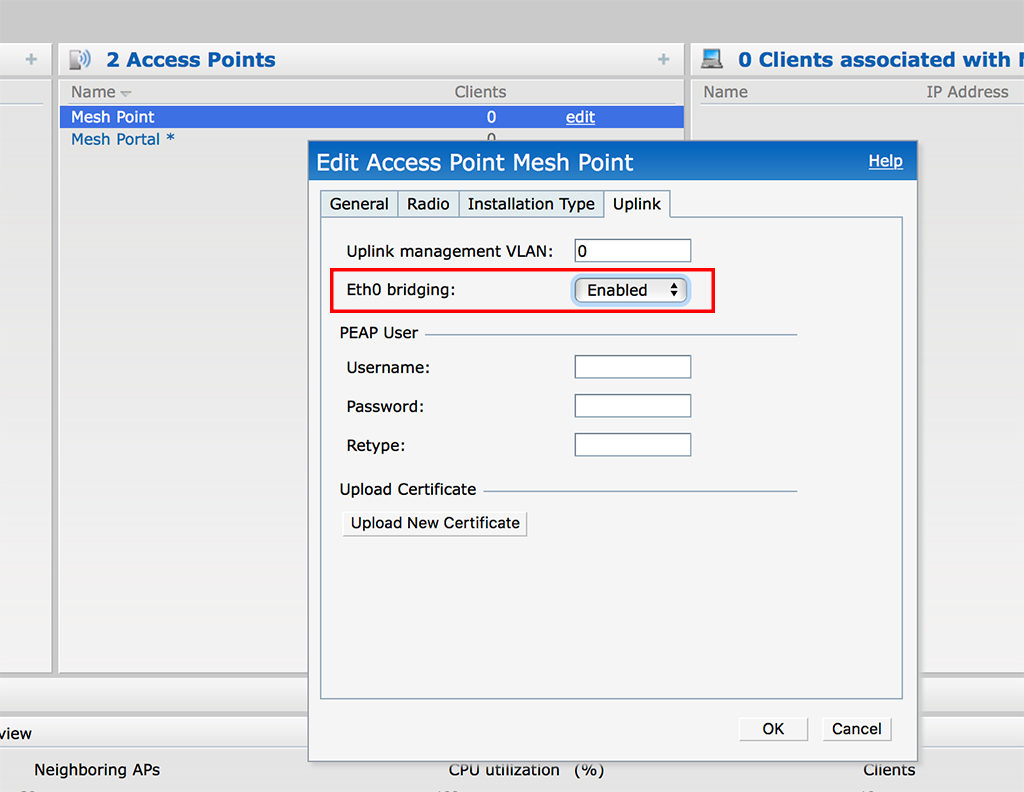
You also need to make sure, that the port of the AP is aware of different VLAN’s. To configure the port accordingly, go to “More–>Wired” and create a new wired network:
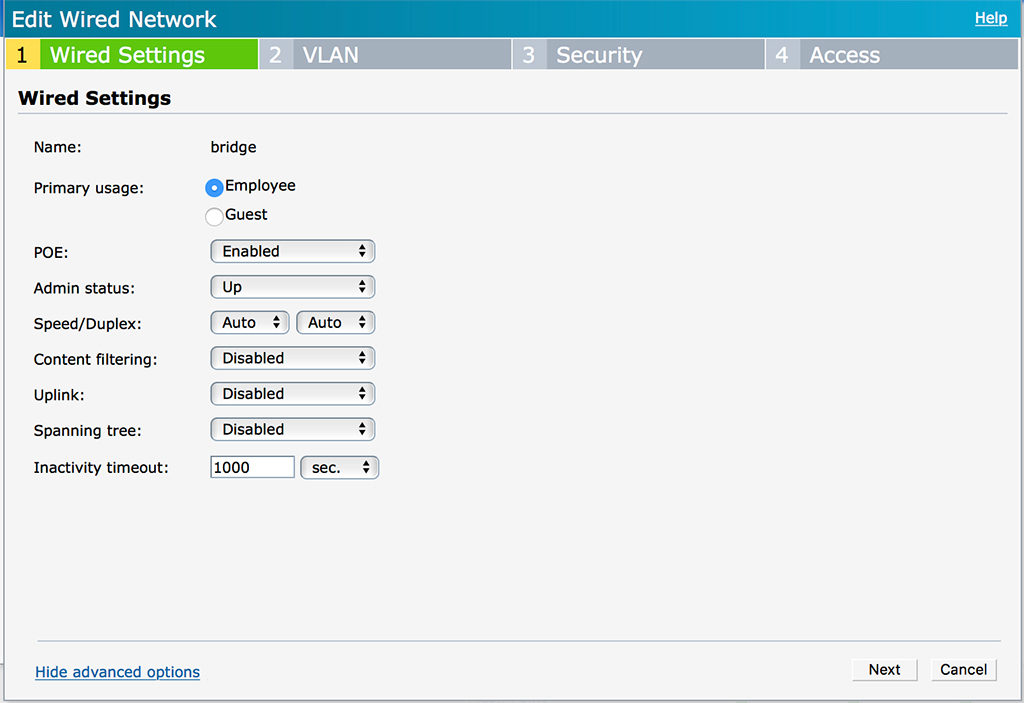
Select “Employee” as “Primary usage” and click “Next”:
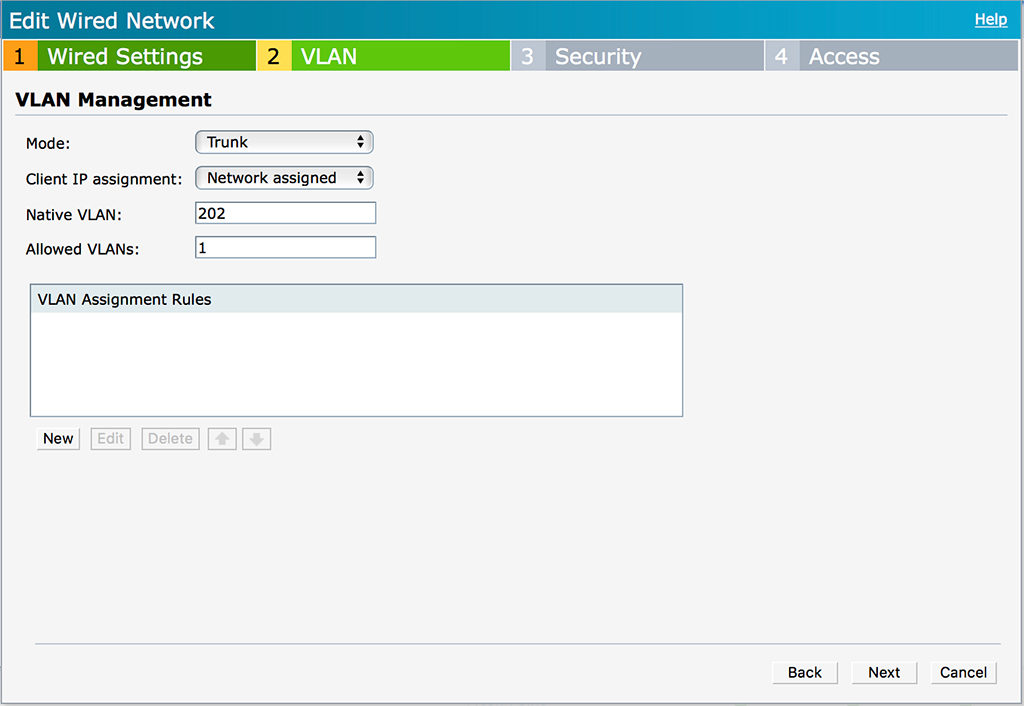
Select “Trunk” as “Mode” and define the “Native VLAN” and the “Allowed VLANs”. You can, of course, have more than one allowed VLAN. Afterward, click “Next”:
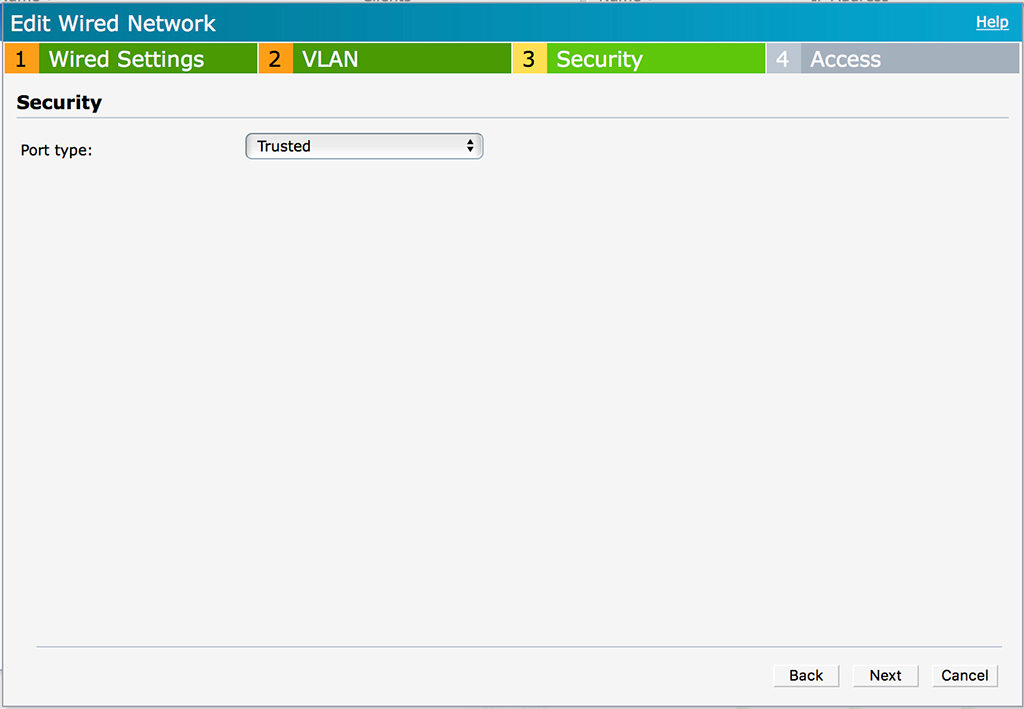
As the Mesh link bridges networks from our domain, we can trust all clients.
On the last tab, the “Access” tag, just click “Finish”.
You can now place the AP wherever you need the AP to interconnect two networks.
If the AP is up and running you can check the status in the CLI:
show ap mesh link
Neighbor list
-------------
MAC Portal Channel Age Hops Cost Relation Flags RSSI Rate Tx/Rx A-Req A-Resp A-Fail HT-Details Cluster ID
--- ------ ------- --- ---- ---- ----------------- ----- ---- ---------- ----- ------ ------ ---------- ----------
38:17:c3:09:92:51 80:8d:b7:10:77:b0 116E 0 1 1.00 C 17m:50s VLK 32 325/325 4 4 0 VHT-80MHzsgi-2ss bfb3420907204759d77aa4aa01e848a
Total count: 1, Children: 1
Relation: P = Parent; C = Child; N = Neighbor; B = Blacklisted-neighbor
Flags: R = Recovery-mode; S = Sub-threshold link; D = Reselection backoff; F = Auth-failure; H = High Throughput; V = Very High Throughput, L = Legacy allowed
K = Connected; U = Upgrading; G = Descendant-upgrading; Z = Config pending; Y = Assoc-resp/Auth pending
a = SAE Accepted; b = SAE Blacklisted-neighbour; e = SAE Enabled; u = portal-unreachable; o = opensystemClients behind the AP are now bridged through the Mesh link as well.
What is your main goal to build a mesh? Interconnect networks or connect AP’s with no wired connection?
If you find this post interesting, leave me a comment and share it with your friends. If you don’t like the post, leave me a comment and share it with your enemy. But whatever you do, leave me a comment, now.
Good job
Hi Manoj,
Thanks for the feedback. Really appreciated.
BR
Florian
Just to add to this, I once had a customer issue where his points kept losing connection to his portal. His portal kept changing channels due to perceived interference and the points would take a while to figure out what was happening. We measured channel utilization around his APs, selected the channel least used by surrounding APs, locked the IAP cluster to that otherwise least-used channel (believe it’s in Access Point Control in the Radio Settings), and his downtime went from six plus hours per week to less than half an hour per week.
Hello, Thank yu Florian for this good tuto, I spends hours searching in offical doc before enconter your blog. And so i could try the solution. Try but not succeed, See that:
After configuring the mesh portal and the mesh point fine cause command line return is ok but webgui show me my mesh point as a portal too, and when i put the supposed mesh point in other segment (other swhitch not wired), then the mesh point come in the webgui (after 16 mn ) but after few minutes it come out and then i can’t test the remote connection, Maybe someone has a clue for get a solution ?
Notice that i try with 2 AP-105 and 6.2.3-4.1.1.3 software wich is a little old. What was you material for this labo ?
Anyway thank you for your sharing, and have a good day.
Hi Joik,
thanks for you comment. I really appreciated your feedback.
first of all, I would recommend upgrading to the latest available version for your platform. This is really old software. Do you have “enet-vlan” configured? I found this in combination with Mesh leads to some problems.
I would also recommend contacting TAC, but you should upgrade first 🙂
Many thanks,
Florian
Very useful, many Thanks!
Hello,
Our AP-377’s have an SFP port for an 1000BASE-X transceiver. Not a copper RJ-45. We can get a copper transceiver, but is there a way to power the eth0 with PoE and data, but the data does not come from the switch the portals are using, but it connects to an end device?
Thanks,
L
Hi Lawrence,
Not sure if I understand you correctly. First, the AP-377 is connected via mesh? No wired connection to the network, correct?
If this is true and you are asking if the IAP can be powered by PoE and still be connected via Mesh, the answer is yes.
I’m actually not sure, what you mean by “it connects to an end device”?
BR
Florian
What a nice post you have right here. Step by step is easy to follow. Thank you for sharing.
what if in the middle of our uplink is lost?
normal topology : IAP – Switch A – wired link – Switch B – IAP
mesh topology: IAP – Switch A – Mesh Portal AP – mesh link – Mesh Point AP (bridging eth0) – Switch B – IAP
can i have mesh topology above?
have you ever tried it?
hi feri,
thanks for the feedback. Really appreciated.
If the mesh link goes down, it will be like any other link, the connection is lost. But if the reason for the error, like a power outage, is resolved the link will reestablish.
You can build the mentioned topology. This is one scenario for mesh links. You can either have all IAP’s in one cluster or, which would be my recommendation, run the mesh IAP’s in standalone mode and have all the other IAP’s in one cluster.
As this looks like a P-t-P link within one campus, you might look at the 387 IAP. This one is designed for such scenarios.
Hope this helps and addresses your questions.
BR
Florian
Florian your post was very helpful to me. Thanks for posting it. I followed the directions and was able to get a Mesh Portal & Point up and running with no issues. I added four new APs to the same cluster and now the mesh point is unreachable. One of the new APs became the Virtual Controller and upgraded the firmware on all of the units. Would this have caused the Mesh Point to become unreachable, or something else that I’m missing?
Thanks again,
Jason
Hi Jason,
what type of IAP is your Mesh Point and what type of IAP’s are the others. Normally, a new IAP should not become VC and upgrade the cluster. Normally, the old VC stays VC until he is rebooted.
BR
Florian
Thanks!
Aruba claims it would work by itself. Nonsense. Maybe with APs for USA and Japan but not for the rest of the world.
Thanks for the detailed instructions. I will come back to this blog.
Hi Klausi,
thanks for the comment. but be aware, this description is for versions <8.4. with version, 8.4 things get easier and my plan is to show this as well in a future post but still missing the time to prepare.
Br
Florian
Hello, my aim is to communicate with 2 plc mesh. I have disabled extended ssd. I made Eth0 bridging enabled, a mesh occurred. It works, no problem, but if I don’t send data for 10 or 20 minutes, it restarts itself and the connection is broken. What is the reason? My wired settings are spanning tree enable uplink enable access mode trunk native vlan all. Inactivity timeout 1000min is breaking but what’s the reason thanks.
Hi Tarik,
from my point of view, the connection should be stable and even if the connection tears down, it should reconnect immediately. There is too little information to really help in this situation. I would recommend opening a ticket with Aruba.
BR
Florian
Very good walk-through. We are constantly having issues with our IAP mesh networks. Either the customer is reporting problems, or we ticket on down APs (Points), or ticket on down downstream switches behind the Points. The mesh cluster shows stable up-times, and no incrementing Link Loss. RF interference has been ruled out, we do not run VHT, remove the mesh cluster channel from the nearby IAP Access cluster, etc etc. The only thing we see from the logs is:
[4093]2020-04-25 23:11:05.213 meshd_read_wlan_packet: WARNING, neighbor already in assoc_neighbors list, possible encryption-type mismatch.
[4093]2020-04-25 23:11:06.211 meshd_read_wlan_packet: WARNING, neighbor already in assoc_neighbors list, possible encryption-type mismatch.
[4093]2020-04-25 23:11:07.235 meshd_read_wlan_packet: WARNING, neighbor already in assoc_neighbors list, possible encryption-type mismatch.
[4093]2020-04-25 23:11:08.656 meshd_read_wlan_packet: WARNING, neighbor already in assoc_neighbors list, possible encryption-type mismatch.
[4093]2020-04-25 23:11:09.209 meshd_read_wlan_packet: WARNING, neighbor already in assoc_neighbors list, possible encryption-type mismatch.
[4093]2020-04-25 23:11:11.229 meshd_read_wlan_packet: WARNING, neighbor already in assoc_neighbors list, possible encryption-type mismatch.
[4093]2020-04-25 23:11:12.664 meshd_read_wlan_packet: WARNING, neighbor already in assoc_neighbors list, possible encryption-type mismatch.
[4093]2020-04-25 23:11:13.277 meshd_read_wlan_packet: WARNING, neighbor already in assoc_neighbors list, possible encryption-type mismatch.
[4093]2020-04-25 23:11:14.225 meshd_read_wlan_packet: WARNING, neighbor already in assoc_neighbors list, possible encryption-type mismatch.
[4093]2020-04-25 23:11:15.223 meshd_read_wlan_packet: WARNING, neighbor already in assoc_neighbors list, possible encryption-type mismatch.
[4093]2020-04-25 23:11:16.247 meshd_read_wlan_packet: WARNING, neighbor already in assoc_neighbors list, possible encryption-type mismatch.
[4093]2020-04-25 23:11:18.076 meshd_update_neighbor: nbr new-mstate:0 should match 0
[4093]2020-04-29 16:06:34.701 meshd_fill_neighbor_row: WARNING parent-bssid not found for child mac: , rssi unreliable.
Hi William,
I see this kind of issue when there is an unstable link or when the link is not able to establish correctly. What I read from your comment, that the link is already established and stable. Did you check to upgrade to a newer firmware?
If you are running on the recent version and the issue is still there, I would recommend contacting Aruba TAC in order to get this solved.
BR
Florian
I would discourage anyone from using Aruba APs based on my experience using them over the past six months. I’ve specifically used models: 505, 367 and 387 in different types of configurations including Mesh and Virtual Controller. Out of the 20 units ordered four of them had to be replaced because they would not work correctly or keep a configuration saved.
It was common to have to reprogram and reboot the APs numerous times in order to get them to save a static IP addresses as well. *IF* you can ever get the APs programmed and running then they seem to do fine, however the lack of Aruba documentation and faulty hardware wasted huge amounts of time and resources.
We have much less expensive Engenius APs running WiFi bridges that have been online for over two years with no issues. If you’re looking for a basic bridge that can carry multiple Vlans then I highly recommend their line of products instead. I spent over 20 hours on the phone/email with Aruba India tech support during the last debacle before they would finally agree that we had a faulty AP. We had the Engenius APs programmed, online and mounted outside within two hours.
It seems that Aruba is trying to pack far too many features into their APs which makes documentation, troubleshooting, and implementation much more difficult than it should be.
Hi Jason,
thanks for your feedback. Did you talked to an Aruba Sales or Presales person about your field experience? This would help Aruba to make the products better.
BR
Florian
In the “InstantAP Mesh – Bridge Wired Traffic” case. If my mesh point AP has eth1 port. Can I bridge to eth1 port.
Hi d5levelfc,
Yes, if you use mesh you can bridge traffic you use the ethernet ports of the AP to bridge traffic through the mesh link.
BR
Florian
Hi Florian,
Thanks for this instruction set.
But I do have a problem with client traffic.
The Mesh seems to work as I can reach the “standalone” mesh point AP.
A switch is connected @ both IAP 315 with vlan 8 native untagged and 23,2080 tagged.
But with a client in VLAN 2080 I cannot reach any destination crossing the WLAN Mesh.
Even I do not see any mac entry on the standalone switch where the “standalone” IAP is connected.
Even the IAPs MAC Adress is not seen
And on the other side I can ony see the local IAP MAC Adress.
Well, I do not have the Option “Eth0 Bridging”, but I guess the “Eth Mode: Downlink” should be same…
Any idea?
Hi Robert,
Not sure what you are referring to, but to get a mesh link to work like you need it, you need to enable “Eth0 Bridging”, as only this option will bridge traffic from the ethernet port to the WLAN and vice versa. Without this option, it will not work. Please double-check for this option. It should be there.
BR
Florian
Hi Florian,
it should be under Configuration –> Access Point –> Mesh Points Settings -> Uplink , right?
But there only stands Eth0 mode Uplink/Downlink and Eth1: Uplink/Downlink, if if the IAP 315 do only have one Ethernet Port…
”
Eth0 wired port can be configured as uplink or downlink. Note that, if neither Eth0 or Eth1 is configured as the uplink, then the access point must use mesh, Wi-Fi or 3G/4G modem as uplink.
”
That sounds very similar to whar I want to do…
Perhaps they changed the sytax, my software Version is “8.9.0.2_83074”?
I’m wondering that I do not see anything in the switch mac table and vice versa I do not see the wired client mac address on the “standalone” Mesh Point IAP.
Hi Florian,
it was my mistake, and oh my god, a beginners mistake…
Switchport has been blocked by Spanning Tree, because of arrivial BPDUs over the WLAN-Bridge.
Now it works as it should!
Thanks and kind regards
Robert
Hi Robert,
great to see that you found the issue. STP is always something you need to consider in those types of setups.
You are also correct, it looks like the setting for enet bridging was changed and your configuration is correct. On the CLI it is still the setting described above in the post.
BR
Florian
Florian,
I am trying to set this up with 2 x AP-377 running 8.10.0.0 and the mesh point will not come up. It is stuck in a BUSY state.
709Point# sh ap mesh link
Module MESH is busy. Please try later.
The Point also stays in a Portal state.
709Point# sh aps
1 Access Point
————–
Name IP Address Mode Spectrum Clients Type IPv6 Address Mesh Role —- ———————- ———————— ——————- ——— ——— ———– ————— — ——————— ———– ————– ———-
709Point 10.24.0.150* access disable 0 377(outdoor) — Portal –
I have disabled extended-ssid and have configured the Point eth0- trusted.
Please advise
Hi Robert,
I would not use 8.10 at the moment. Not because it is not a good release, but it is the first release of this major version. Could you please try with 8.7.x, which I currently, as of today, would recommend for the most productive environments.
If this does not help, let’s check again for more details in the logs.
BR
Florian
Hi Florian,
is there a way under “Aruba Mesh” to set priority routes?
(routes on layer 2, mesh/802.11s is sooo weird 😉
I have this problem:
explanation:
MPP = Aruba Mesh Portal AccessPoint/AP
MP = Aruba Mesh Point AP
means wifi (mesh) link
This, the Aruba (Instant)OS makes with the mesh routing:
MPP1 MP1
MPP1 MP2
This, I would prefer
MPP1 MP1 MP2
Reason:
rx [dB] and SNR between MPP1/MP2 are bad.
rx, SNR between MPP1/MP1 and between MP1/MP2 are good.
Aruba (Instant)OS LOVEs the direct way, LOVEs one hop! Sometimes, it’s not easy to retrace this!
In some secial cases, I would prefer to make a mesh-routing-decision, like
Prioization: MPP1 MP1 MP2
no prioized: MPP1 MP2
and observe the achievable bandwith.
The problem arised in a large school building: long corridors, many classrooms, APs (MPPs, MPs) only in every classroom. The last classroom (MP2) prefers an MPP far away, but, many others MPs are nearby, mostly of the construct:
MPPx MPx
So I want
MPPx MPx MP2 :-)))
If you have an idea, this would be great!
Greets
Andreas
Hi Andreas,
Thanks for sharing this. This sounds like an interesting setup, but unfortunately, I’m not aware of any prioritization at that level. The Mesh Point will always try to connect to the nearest Mesh Portal. Only, if this is not possible, it will use Mesh Points and create a MultiHop Architecture.
I would recommend getting in touch with someone from Aruba directly to discuss this setup and find a solution. This would go beyond the scope if this blog 🙂
BR
Florian
Hello Florian!
Nice article! I tried to get this to work with RAP-155s, running 8.6.0.16, the latest release that supports these APs. I once briefly saw the mesh working without doing anything, but had to enable extended-ssid for an experiment. But since then I disabled extended-ssid, rebooted and verified, but the UI’s mesh devices page stays completely empty, and the same goes for the cli.
I tried “show ap mesh debug”, but the only response I get from it is “no mesh supported in current mode”.
Do you have any idea what I could be doing wrong or missing? I spent already hours of searching the web, but there’s nothing around that helps me debug this.
cli status for reference:
“`
aruba01# show ap mesh cluster configuration
Mesh cluster name :localcampus
Mesh cluster key :Manual
aruba01# show ap mesh cluster status
Mesh cluster :Enabled
Mesh cluster name :localcampuse
Mesh mobility :Disabled
aruba01# show ap mesh cluster topology
aruba01# show ap mesh debug
No mesh supported in current mode
aruba01# show ap mesh link
No mesh supported in current mode
aruba01# show ap mesh neighbours
No mesh supported in current mode
aruba01# show swarm state
AP Swarm State :swarm_config_sync_complete
mesh auto eth0 bridging :no
Config in flash :yes
factory SSID in flash :no
extended-ssid configured :no
extended-ssid active :no
advanced-zone configured :no
Factory default status :no
Source of system time :NTP server
Config load cnt :1
VC Channel index :1
IDS Client Gateway Detect :yes
Config Init success cnt for heartbeat :0
Config Init success cnt for register :0
Config Init skipping cnt for heartbeat :0
Config Init skipping cnt for register :0
Config Init last success reason :N/A
Config Init last success time :N/A
Radio down state :0x0 / 0x0
Thermal Protect state :None
aruba01#
“`
Best regards,
Andre
Hi Andre,
that’s hard to say, did you have a valid SSID configured? It will not work without at least one valid SSID.
BR
Florian
Hello,
just a question: the parameter ETH0 bridging seems to have disapeared from Aruba console, it can still be configured by cli but no more access with graphic mode: has anyone noticed that and why?
thx
Hi,
I was confused by this as well. But the answer is simple. It is now called “Eth0 Mode” and you need to select “Downlink” to enable ETH0 brdiging.
BR
Florian
Hi Florian, thank you for your manual. Do you know if there is any possibility to prohebit a mesh portal ap to become a mesh point, when it loses its wired uplink? We only want to use some specific access points as mesh points.
Hi Caro,
to my knowledge, this is not possible. The definition of a mesh portal is, that the AP is enbaled for mesh and that the AP has an active wired connection. The definition for a mesh point is that it has mesh enabled and no wired connection, except if eenet bridging is enabled. So if a mesh portal loses the uplink, it will automatically become a mesh point.
The only way of somehow make sure it will not become a mesh point is to power the mesh portal with PoE. If the uplink will go down this should also remove the power on the uplink and make the AP go offline.
Maybe this will help.
BR
Florian
Hi Florian,
thank you very much for this blog.
Do you have experience with the IAP 305 8.6.0.6 Ursa?
I would like to use the IAP as a standalone and use it for WLAN measurement(Ekahau) via power supply.
However, as soon as I remove the LAN, the SSID is no longer broadcast/visible.
I found nice information in other blogs that you have to make a setting here, but I stumbled upon the setting under Network/Advanced/Miscellaneous: if the primary uplink has failed: Activated. If activaited is this the setting with which I can implement my case?
I thank you for your help.
Best regards
Antonio
Hi Antonio,
have you already checked this link:
https://community.arubanetworks.com/community-home/digestviewer/viewthread?MID=47970#bm567fffd3-65d2-49e9-9eed-e5c6e0713b94
There are plenty of information on how to handle this kind of situation.
So far, I haven’t seen any issues, using an IAP for site surveys.
BR
Florian
Good morning Florian,
Thank you very much for the link, I will
test it straight away and report back.
It looks like I’m missing the static IP address and the uplink settings.
Let’s see if my WebUI can handle it.🙂
Thank you again for your blog.
Best regards
Antonio
Hi Florian, I tried the link and lo and behold it worked.
Thank you for the help and your blog. I’ll check in more often 🙂
Many greetings
Antonio
Hi Antonio,
Thanks for the feedback. Much appreciated and glad to see that it is now working for you.
BR
Florian